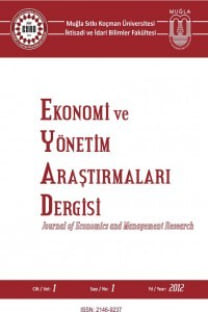İSTİHDAM OLASILIĞINI BELİRLEYEN FAKTÖRLERİN ETKİSİ KADIN VE ERKEKLERDE AYNI MI? 2004 VE 2013 HANEHALKI İŞGÜCÜ ANKETLERİ ÜZERİNDEN BİR ANALİZ
İstihdam Olasılığı, Probit Modeli, Cinsiyetler Arası Farklar
IS THE EFFECT OF FACTORS DETERMINING EMPLOYMENT PROBABILITY SAME FOR WOMEN AND MEN? AN ANALYSIS OVER 2004 AND 2013 HOUSEHOLD LABOR FORCE SURVEYS
___
- Ellwood, D. T. (1982). Teenage Unemployment: Permanent Scars or Temporary Blemishes? R. B. Freeman, & D. A. Wise içinde, The Youth Labor Market Problem: Its Nature, Causes, and Consequences (s. 349-390). Chicago: University of Chicago Press.
- Felmlee, D. H. (1984). A Dynamic Analysis of Women's Employment Exits. Demography, 171-183.
- Gedikli, Ç. (2014). Female Labour Supply in Turkey: Do Traditional Gender Roles Matter? 33rd IARIW General Conference, the Netherlands, (s. 1-47). Rotterdam.
- Göksel, İ. (2010). Conservatism and Female Labor Force Participation in Turkey. IEA Annual Conference Ireland.
- Hester, C. H., Meyer, C., & Raphael, S. (2012). The Evolution of Gender Employment Rate Differentials within Racial Groups in the United States. The Journal of Legal Studies, 41(2), 385-418.
- Kılıç, D., & Öztürk, S. (2014). Türkiye’de Kadınların İşgücüne Katılımı Önündeki Engeller ve Çözüm Yolları: Bir Ampirik Uygulama. Amme İdaresi Dergisi, 47(1), 107-130.
- Kızılgöl, Ö. A. (2012). Kadınların İşgücüne Katılımının Belirleyicileri: Ekonometrik Bir Analiz. Doğuş Üniversitesi Dergisi, 13(1), 88-101.
- Kumaş, H., & Çağlar, A. (2011). Türkıye’de Kadın Eksik İstihdamını Belirleyen Faktörler: Tüik 2009 Hanehalkı İşgücü Anketi Ham Verileri İle Cinsiyete Dayalı Bir Karşılaştırma. Çalışma ve Toplum(2), 249-289.
- Lynch, L. M. (1989). The Youth Labor Market in the Eighties: Determinants of Re-employment Probabilities for Young Men and Women. The Review of Economics and Statistics, 71(1), 37-45.
- Mincer, J. (1962). Labor Force Participation of Married Women: A Study of Labor Supply. Universities-National Bureau Committee for Economic Research (s. 63-105). Princeton: N.J.: Princeton University Press.
- Misra, J., Kennely, I., & Karides, M. (1999). Employment Chances in the Academic Job Market in Sociology: Do Race and Gender Matter? Sociological Perspectives, 42(2), 215-247.
- Rees, H., & Shah, A. (1986). An Empirical Analysis of Self-Employment in the U.K. Journal of Applied Econometrics, 1(1), 95-108.
- Roberts, M. (1972). Some Factors Affecting Employment and Earnings of Disadvantaged Youths. Industrial and Labor Relations Review, 25(3), 376- 382.
- Scott, L. C., Smith, L. H., & Rungeling, B. (1977). Labor Force Participation in Southern Rural Labor Markets. American Journal of Agricultural Economics, 59(2), 266-274.
- ISSN: 2146-9237
- Başlangıç: 2012
- Yayıncı: Mugla Sitki Kocman University
DAĞITILMAYAN YABANCI KARLARIN BELIRLEYICILERI
İbrahim GİRİTLİOĞLU, Halil İbrahim KARAKAN, Bilal Nadir ALKAN, Harun Reşit GÜNDOĞAN
SON DÜZENLEMELER IŞIĞINDA İHRACATTA KDV’NİN İADESİ VE MUHASEBELEŞTİRİLMESİ
YOKSULLUKLA MÜCADELEDE SOSYAL KORUMA HARCAMALARI: AVRUPA BİRLİĞİ ÜLKELERİ ÜZERİNE BİR İNCELEME
SOSYAL DEVLET ANLAYIŞININ YEREL KARŞILIĞI: SOSYAL BELEDİYECİLİK VE TEMEL SORUNLARI
